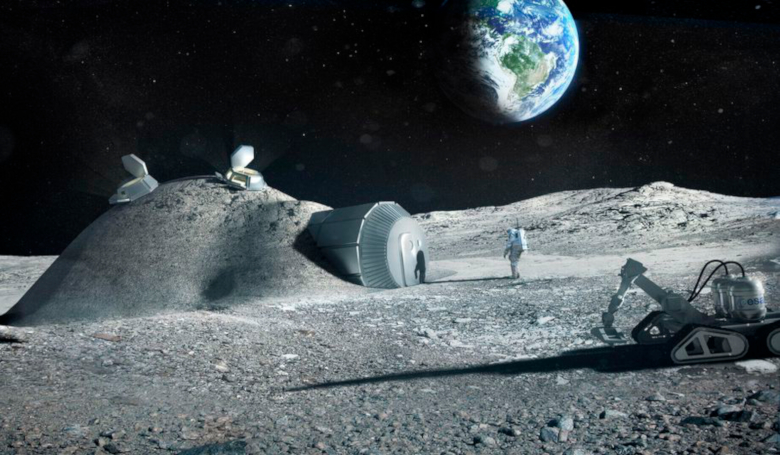Two new exciting discoveries by scientists using the airborne telescope known as SOFIA (Stratospheric Observatory for Infrared Astronomy) are cementing our understanding of water on the Moon. Previously, water ice in the form of OH (hydroxyl) locked in lunar regolith had been detected, but now research teams have unambiguously detected the H2O molecule, while another suggests that approximately 40,000 km2 of the lunar surface has the capacity to trap water.
Prospecting for water on the Moon is a serious business. In order to establish a long-term presence on the Moon, extracting water from the surrounding environment is essential, as not only is water essential for survival, it can also be used to make rocket fuel and it is too expensive to transport water from Earth.
So, when both India's Chandrayaan-1 spacecraft and NASA’s Lunar Reconnaissance Orbiter (LRO), detected signatures interpreted as water in sunlight reflected from the Moon's surface a couple of years ago, things started looking up for potential long-term settlers.
However, as striking as these results were, scientists at the time were not sure whether the hydrated lunar regolith was molecular water (H2O) or other hydroxyl (OH) compounds as both have chemical signatures at 3µm (micrometers) – the portion of the electromagnetic spectrum they were detected in – and it was difficult to discriminate between the two.
Neither was it clear just how widespread the water might reach. It was suggested that at the very least, water ice would be trapped in large permanently shadowed regions in the Moon’s polar regions; regions known for their extremely low temperatures.
Interestingly, it was thought that if water was sheltering in the lunar subsurface, chances are it had been there, undisturbed, for a very, very long time.
With motivations to determine just how wet the Moon is and what type of water it is, scientists have now made a significant breakthrough with the help of a modified Boeing 747SP aircraft that is equipped with a 2.7-metre reflecting telescope; the NASA/DLR Stratospheric Observatory for Infrared Astronomy (SOFIA).
As its name suggests SOFIA is able to detect emission in the infrared and by examining a different band of radiation, a team of researchers headed by Casey Honniball at the University of Hawaiʻi, were able to clarify a water signature in the form of H2O at 6µm.
This spectral signature at 6 μm is not shared by other hydroxyl compounds say the team, so its identification is without doubt that of H2O and based on the strength of the 6 μm band, the team estimate abundances of around 100 to 400 parts per million.
Honniball and colleagues also suggest that the detected water is probably stored in glass or between grains on the lunar surface that protect it from the harsh environment.
Whats more, the distribution of water is over a small latitude range and is probably not a global phenomenon, the team add.
Just how far this range extends could be answered by another study published today by a different team of scientists who have examined the distribution of permanently shadowed areas, known as cold traps.
Cold traps are places where water delivered to the lunar surface could be captured and held permanently.
Using theoretical models and data from NASA’s Lunar Reconnaissance Orbiter, the team estimate how much water could be hiding in shadows on scales from 1 kilometre right down to 1 centimetre.
These latter sized shadows are dubbed ‘micro’ cold traps, and are the smallest distance over which the team find cold-trapping to be effective for water ice.
It turns out, these small scale ‘micro’ cold traps are hundreds to thousands of times more numerous than larger cold traps, and they can be found at both poles. They are also ideal in sequestering H2O and from stopping the water molecules from roaming around the surface too far.
The team, headed by Paul Hayne at the University of Colorado Boulder, Boulder, suggest that approximately 40,000 square kilometres (km2) of the lunar surface has the capacity to trap water and about 60 percent of it can be found in the south.
“A majority of cold traps for water ice is found at latitudes > 80° because permanent shadows equatorward of 80° are typically too warm to support ice accumulation,” say the authors in their research paper.
Hayne and colleagues findings indicate that water is efficiently produced or delivered on the Moon by various processes and may be more widely distributed than thought. They also state that as water is lost easily to micro-meteorite impacts and the breakdown of H2O molecules by ultraviolet light, the detection of water within the micro cold traps "would imply recent accumulation", though they don't discuss how it might have got there.
With agencies such as NASA and private firms gearing up to mine the Moon, these latest results could bode well for the many missions heading to our nearest celestial neighbour in the next few years.
“If water is found in micro cold traps, the sheer number and topographic accessibility of these locales would facilitate future human and robotic exploration of the Moon,” say Hayne and colleagues.
Both studies have been published in Nature Astronomy today.











